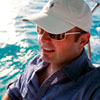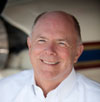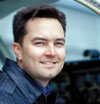Hangar Talk
The story behind the story
 “Americans are notoriously bad at geography, and I’m afraid that I fit that stereotype,” says Senior Editor Dave Hirschman. “I knew the Bahamas was somewhere off the east coast of Florida, but I had no idea just how close and accessible the islands are via general aviation” (“ Another Day, Another Island ,”). Just 20 minutes after leaving Fort Lauderdale in a fixed-gear, single-engine Cessna Caravan, the lumbering utility airplane overflew Bimini, the nearest island in the archipelago. Less than an hour later, it crossed over Nassau, the capital city. “Even though we were flying into a stiff headwind in a loaded airplane that no one would describe as a speed demon, the flight to Stella Maris in the southern portion of the island chain took less than three hours,” Hirschman says. “Once there, winter’s sleet, snow, and even the NFL playoffs seemed like distant memories.”
“Americans are notoriously bad at geography, and I’m afraid that I fit that stereotype,” says Senior Editor Dave Hirschman. “I knew the Bahamas was somewhere off the east coast of Florida, but I had no idea just how close and accessible the islands are via general aviation” (“ Another Day, Another Island ,”). Just 20 minutes after leaving Fort Lauderdale in a fixed-gear, single-engine Cessna Caravan, the lumbering utility airplane overflew Bimini, the nearest island in the archipelago. Less than an hour later, it crossed over Nassau, the capital city. “Even though we were flying into a stiff headwind in a loaded airplane that no one would describe as a speed demon, the flight to Stella Maris in the southern portion of the island chain took less than three hours,” Hirschman says. “Once there, winter’s sleet, snow, and even the NFL playoffs seemed like distant memories.”
 The quality of light and the variety of backgrounds in the Bahamas makes shooting photos there a photographer’s dream. “You’ve got thick forests and mangroves, white sand, and water of every shade of blue—all within tiny geographic areas,” says AOPA Photographer Chris Rose (“ Another Day, Another Island ,”). “Frankly, I didn’t notice some of the backgrounds until I got home and started looking at the photos. The backgrounds change so rapidly during an aerial photo shoot that it’s almost impossible to anticipate them.” The natural colors are so vibrant that Rose said he had to tame some of them down to prepare them for publication. “I’ve been going to the Bahamas since I was 15 years old, and I always look forward to going back,” he says. “The people are so gracious and friendly. Anything they can do to make your experience better, they seem glad to do. My only complaint was that the winter days are relatively short, so each day ended too soon. ”
The quality of light and the variety of backgrounds in the Bahamas makes shooting photos there a photographer’s dream. “You’ve got thick forests and mangroves, white sand, and water of every shade of blue—all within tiny geographic areas,” says AOPA Photographer Chris Rose (“ Another Day, Another Island ,”). “Frankly, I didn’t notice some of the backgrounds until I got home and started looking at the photos. The backgrounds change so rapidly during an aerial photo shoot that it’s almost impossible to anticipate them.” The natural colors are so vibrant that Rose said he had to tame some of them down to prepare them for publication. “I’ve been going to the Bahamas since I was 15 years old, and I always look forward to going back,” he says. “The people are so gracious and friendly. Anything they can do to make your experience better, they seem glad to do. My only complaint was that the winter days are relatively short, so each day ended too soon. ”
 “There’s nothing macho about Ercoupes, but with enough time in one they grow on you,” Editor at Large Tom Horne says of the model 415-C Ercoupe flown for his story “ Budget Buy: Easy Flyer ”. The design may seem dated today, but the Ercoupe was a star in the late 1940s, with its tricycle gear, all-aluminum construction, and many safety features. “A lot of the airplane’s flying procedures seem counterintuitive at first,” Horne says. “But with an airplane so easy to fly, it’s plenty forgiving. And with 2,400 Ercoupes still flying, the 415-C is a great option for flying under LSA rules. The airplane gets the looks on the ramp, and it’s ideal for those with nothing to prove except the need for fun flying at very reasonable costs.”
“There’s nothing macho about Ercoupes, but with enough time in one they grow on you,” Editor at Large Tom Horne says of the model 415-C Ercoupe flown for his story “ Budget Buy: Easy Flyer ”. The design may seem dated today, but the Ercoupe was a star in the late 1940s, with its tricycle gear, all-aluminum construction, and many safety features. “A lot of the airplane’s flying procedures seem counterintuitive at first,” Horne says. “But with an airplane so easy to fly, it’s plenty forgiving. And with 2,400 Ercoupes still flying, the 415-C is a great option for flying under LSA rules. The airplane gets the looks on the ramp, and it’s ideal for those with nothing to prove except the need for fun flying at very reasonable costs.”
 The middle of the 1960s was an exciting time for GA. Manufacturers were churning out new models with fury, many of them edgy and exciting. British Executive and General Aviation Limited (BEAGLE) wanted some of the action after sales of British cars began sagging—idling the workers at parent company, Pressed Steel. The result is the stout “light” twin, the Beagle B206. From a sales and manufacturing standpoint, the built-by-hand Beagle was a failure compared to its mass-assembled brethren in the United States. Only 43 were built. But a lucky few owners have held on to the few copies of this unique airplane. Gene Whiddon and Jim Hill Jr. are the type’s biggest promoters, and with good reason—the airplane is a joy to fly and stands tall above the throngs of “typical” twins. Pete Bedell tells the story of the airplane in “ Britain’s Brawny Beagle ”.
The middle of the 1960s was an exciting time for GA. Manufacturers were churning out new models with fury, many of them edgy and exciting. British Executive and General Aviation Limited (BEAGLE) wanted some of the action after sales of British cars began sagging—idling the workers at parent company, Pressed Steel. The result is the stout “light” twin, the Beagle B206. From a sales and manufacturing standpoint, the built-by-hand Beagle was a failure compared to its mass-assembled brethren in the United States. Only 43 were built. But a lucky few owners have held on to the few copies of this unique airplane. Gene Whiddon and Jim Hill Jr. are the type’s biggest promoters, and with good reason—the airplane is a joy to fly and stands tall above the throngs of “typical” twins. Pete Bedell tells the story of the airplane in “ Britain’s Brawny Beagle ”.


